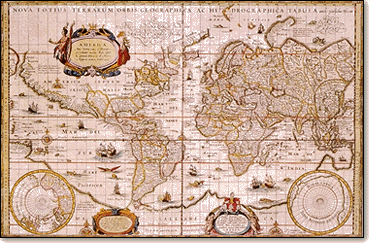
Map of the World, 1606
Eventually the Spanish ruled over a vast domain in the Americas. The colonies of Spain included what is present-day Mexico, Central America, the Antilles islands, California, New Mexico, Texas, the coast of the Gulf of Mexico from Lousiana to the tip of Florida, Ecuador, Panama, Colombia, Peru, Bolivia, Argentina, and Uruguay. These domains were divided into the viceroyalties of New Spain, New Granada, Peru, and La Plata. There was one Portuguese viceroyalty, that of Brazil. Most of the museum's collections represent the viceroyalty of New Spain and are particularly strong in objects from Mexico.